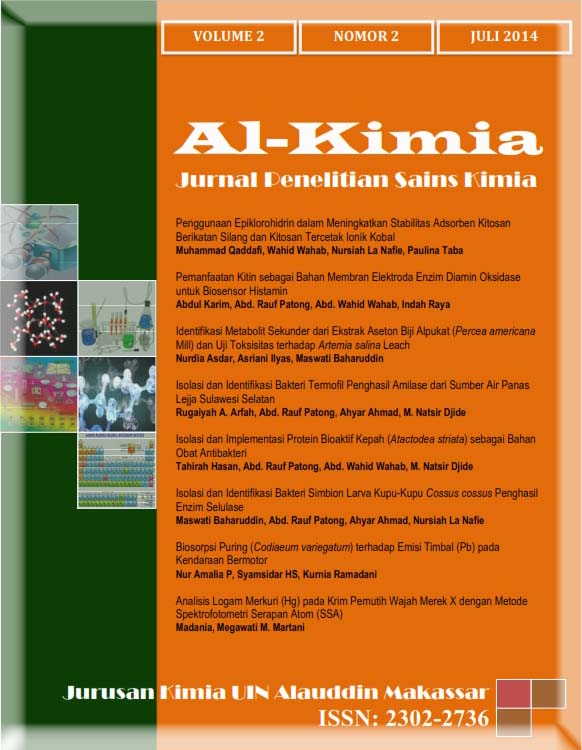Isolasi dan Implementasi Protein Bioaktif Kepah (Atactodea striata) Sebagai Bahan Obat Antibakteri
Abstract
This study aimed to 1) determine the degree of saturation of ammonium sulfate right to extract and purify the bioactive protein from shells (Atactodea striata), 2) determine the fraction of active protein from shells (Atactodea striata) as a potential antibacterial. In this study used the Lowry method for determine protein concentration and agar diffusion method for antibacterial activity. Extraction of shells Atactodea striata was conducted by making use of buffer solution (0,1 M Tris-HCl of pH 8.3, 2 M NaCl, 0.01 M CaCl2, 1 % β-mercaptoethanol, and 0.5 % Triton X-100). Purification of proteins by precipitation using ammonium sulfate at saturation level 30 %, 50 %, 70 %, and 90 %. The results showed that the protein concentration of the crude extract is 41.6354 mg/mL. At fractionation rate of 0-90% saturation showed the highest concentration of protein found in fractions with 70% saturation level is 56.4184 mg/mL. The testing of antibacterial activity against Staphylococcus aureus showed that crude extracts and protein fractions Atactodea striata is considered effective as an antibacterial. The highest bioactivity during 24-hour incubation in protein fractions obtained by ammonium sulfate saturation level of 50% is 25.17 mm. Whereas the lowest activity was obtained at 90% saturation level is 14.05 mm. Bioactivity against Escherichia coli after incubation for 24 hours has the highest activity in the protein fraction with 30% ammonium sulfate saturation is 15.12 mm. Whereas the lowest activity was showed at 70% saturation level is 10.30 mm. After the observation was continued for 48 hours on both test bacteria, which formed a clear area becomes cloudy. It shows that the crude extract and fractions of protein tend to be bacteriostatic against Staphylococcus aureus and Escherichia coli.
Downloads
References
Ahmad, A., Karim, A., dan Arief, A. 2007, Bioaktifitas Antimikroba dan Antikangker Fraksi Protein yang Diisolasi dari Beberapa Spesies Spons di Pulau Barang Lompo Sulawesi Selatan. Proseding Seminar Nasional Research Grand TPSDP Bateh II, Bali.
Al-Baarri, A. N., Ogawa, M., and Hayakawa, S. 2011, Aplication of Lactoperoxidase System Using Bovine Whey And The Effect Of Storage Condition On Lactoproxidase Activity, Intenational Journal of Dairy Science, 6: 72-78.
Bachok, S., P. L. Mfilinge, and M. Tsuchiya, 2006, As Indicated Suspension- Feeding Bivalvesrces of Coexisting Subjected to Bivalves Abundance on a Tidal Flat, Journal of Sustainability Science and Manaement, 1:92-111.
Balcazar, J.L., Blas, Ruiz Zarzuela, D. Cuningham, Vendrell and Muzquiz,2006, The Rute of Probiotic in Aquaculture. Veterinary Microbial.,114:173-186.
Barnes RD., 1982, Invertebrate Zoology, Saunders College, Fourth Editin. Blunt, J. W., Copp, B.R., Munro, M.H.G., Northcote and Prinsep, M.R. 2006,Marine Natural Products, Natural Product Reports, 23: 26-7
Djide, M.N., Sartini, 2008, Dasar-Dasar Mikrobiologi Farmasi, Makassar: Fakultas Matematika dan Ilmu Pengetahuan Alam Universitas Hasanuddin.
Huang. L, 1999, Protein dalam Air Mata Obat untuk AIDS, Online, http://www.rad.net.id/warta/wao4701.htm, (diakses 2 Januari 2013).
Moka, W., 1982, Identifikasi dan Inventarisasi Jenis kerang Laut Yang Digunakan Sebagai Obat Tradisonal Di Sulawesi selatan, Makassar: Universitas Hasanuddin.
Naim, R., 2008, Protein Antimikroba dalam Susu, Online, http://www.poultryindonesia.com, (diakses 3 Januari 2013).
Nurjanah, L. Hardjito, D. Monintya, Bintang M., & D.R. Agungpriyono, 2009,
Aktivitas Antioksidan Lintah Laut (Discodoris sp) dari Perairan Pulau Lintah Laut dari Perairan Pulau Buton Sulawesi Tenggara. Prosiding Seminar Nasional Pengolahan Produk dan Bioteknologi Kelautan dan Perikanan. Jakarta
Nurjanah, A. Abdulla, dan A. Apriand, 2011, Aktivitas Antioksidan daan Komponen Bioaktif Pada Keong Ipong-Ipong (Fasciolaria salmo), Jurnal Pengolahan Hasil Perikanan Indonesia, XIV(1): 22-29.
Plummer, D.T., 1979, An Introduction to Practical Biochemistry. Second Edition. Tata Mc. Graw Hill Publishing Company Ltd. New Delhi.
Salamah, E., E. Ayuningrat, dan S. Purwaningsih, 2008, Penapisan Awal Komponen Bioaktif dari Kijing Taiwan (Anadonta woodiana Lea.) sebagai Senyawa Antioksidan. Buletin Teknologi Hasil Perikanan, 11(2): 119-132.
Scopes, R.K., 1987, Protein Purification Principles and Practice, Second edition, New York: Springger-Verlag.
Stanbury, P.F., and J.R. Whitaker, 1984, Principle of Fermentation Technology, New York: Academic Press.
Wattimena, J.R. 1991, Farmakodinamika dan Terapan Antibiotik, Yogyakarta: Gadjah Mada University Press.
Zhou, D.Y., B.W. Zhu, L. Qiao, H.T. Wu, D.M. Li, J.F. Yang, and Y. Murata, 2011, In Vitro Antioxidant Activity of Enzymatic Hydrolysates Prepared From Abalone (Haliotis Discus Hannai Ino) Viscera. Food and Bioproducts Processing, in press.
Authors who publish with this journal agree to the following terms:
1) Authors retain copyright and grant the journal right of first publication with the work simultaneously licensed under a Creative Commons Attribution License that allows others to share the work with an acknowledgement of the work's authorship and initial publication in this journal.
2) Authors are able to enter into separate, additional contractual arrangements for the non-exclusive distribution of the journal's published version of the work (e.g., post it to an institutional repository or publish it in a book), with an acknowledgement of its initial publication in this journal.
3)Authors are permitted and encouraged to post their work online (e.g., in institutional repositories or on their website) prior to and during the submission process, as it can lead to productive exchanges, as well as earlier and greater citation of published work (See The Effect of Open Access).


